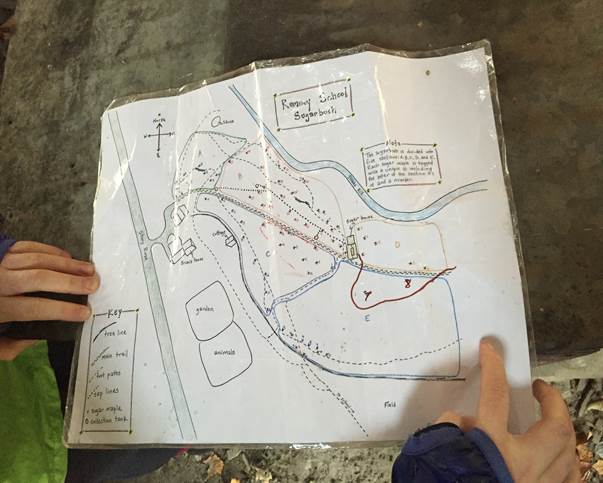This is the question that six students from UVM’s Rubenstein School for Environment & Natural Resources set out help us answer this past fall. Kirchner Woods was home to Jerry Kirchner’s sugaring operation on Taber Hill for more than 40 years and is still rich in maples today, so there’s no doubt that the forest could still be managed as a productive sugarbush. However, maple sugaring at any scale is intensive and expensive work. Before rushing out to hang buckets or rebuild Jerry’s sugarhouse, the students helped us take a practical look at a variety of possible models for setting up a small-scale, educational sugaring operation on the property by conducting a feasibility study.
Can We Bring Maple Sugaring Back to Kirchner Woods?


Finding a good model
The students started by interviewing local sugarmakers and visiting established educational sugaring operations including the Green Mountain Audubon Center in Huntington and Rumney School in Middlesex. They gathered information and opinions about everything involved in setting up and running a successful small-scale operation from equipment and labor needs and costs to deciding on an appropriate scale and method for sap collection to strategies for community engagement and education.
Green Mountain Audubon Center, Huntington
- 500 taps – buckets only
- Small sugarhouse for education & large sugarhouse for production
- Hire two seasonal sugarmakers
- Offer educational tours and programs
Shelburne Farms, Shelburne
- 600 taps – buckets & tubing
- Built a new, large sugarhouse for commercial production
- Offer educational tours & programs
- Sell syrup on farm


Rumney School, Middlesex
- 50 taps – buckets & tubing
- Small sugarhouse for education
- Operated by students, teachers & volunteers
- Next to school – all students participate every year
The best fit
The Rumney School’s 50-bucket educational operation stood out as the best potential model for small-scale community sugaring at Kirchner Woods. Rumney’s sugarbush and small sugarhouse – located next to the school - are owned and primarily operated by a volunteer neighbor. Each spring since 2004, all the students have helped out with tapping, gathering sap, and boiling with assistance from teachers, volunteers, and neighbors. Students also design a bottle label and sell the 5-10 gallons of syrup to community members by the pint.
According to the UVM students, Stowe Elementary School ‘s principal, Richard Smile, was enthusiastic about the possibility of having students visit and learn about sugaring at Kirchner Woods, and thought that there would be strong support from Stowe families to help out. However, location could be a barrier to crafting an arrangement like Rumney School’s; instead of a being next door to Stowe Elementary School, Kirchner Woods is two miles away up Taber Hill Road.
Gauging community interest
The students also conducted an online survey to gauge community interest in and support for bringing sugaring back to Kirchner Woods. In general, of those who responded (about 20), were supportive of seeing a sugarhouse and buckets return to the property, but were less enthusiastic about modern sap collection equipment like plastic tubing and a tractor or ATV. This response makes sense given that 75% of respondents said that they thought the biggest benefit to bringing sugaring back would be that it represents a historic tradition.
Will we do it? Time will tell.
The feasibility study has reinforced for us how exciting it would be to see sugaring return to Kirchner Woods. It has also helped us take a hard look at the significant commitment of time, money, and resources needed to set up and run even a small-scale operation. After careful consideration, we’ve decided that these investments are more than we can make right now.
However, if the right opportunities and forces align, it’s something we’d like to pursue in the future. Until then, we will continue to manage Kirchner Woods for recreation, big maples, forest health, high-quality wildlife habitat, and other forest products like firewood and timber. Doing so continues to leave the door open for sugaring down the road.
Other ways to celebrate sugaring
In the meantime, we’ve identified creative, less intensive ways to feature and celebrate Kirchner Woods’ sugaring history and the importance of maple sugaring in our current community and forest economy. Here are some ideas we’d like to pursue:
- Determine if any local sugarmakers would have an interest in leasing taps on a small portion of the property – likely along Taber Hill Road.
- Organize “pop-up” community sugaring events at Kircher Woods. Hang a few buckets, boil sap over a fire, and voila!
- Team up with local sugarmakers to offer educational tours and community events at existing sugaring operations.
- Create interpretive materials (e.g. signs, a map & guide) about the history of sugaring on the property
A bonus outcome
One of the best parts of partnering with UVM’s School for Natural Resources to do the feasibly study was getting to meet and work with the students. They were all eager to learn more about sugaring as well as Stowe – a place that many of them had visited to ski or hike, but a community they knew little about. Being able to offer these college seniors a meaningful service-learning opportunity as they get ready to choose and pursue their careers was a great outcome of this partnership in and of itself.
Places to see maple sugaring in Stowe
- Nebraska Knoll Sugar Farm, Falls Brook Lane off of Nebraska Valley Road
- Stowe Maple Products, Route 100 & Moscow Road
- Percy Sugarhouse, Weeks Hill Road
- Trapp Family Lodge Sugarhouse, Trapp Hill Road
The 2016 Vermont Sugarmakers Open House Weekend is April 2-3. Check out the Vermont Maple Sugar Makers Association webpage for a listing of all participants.





